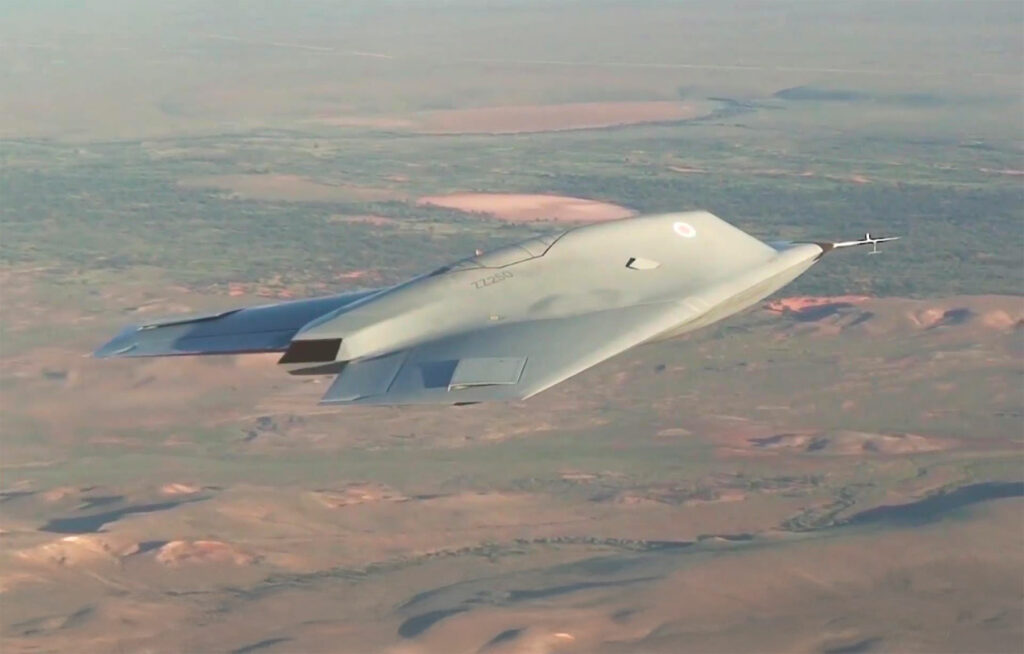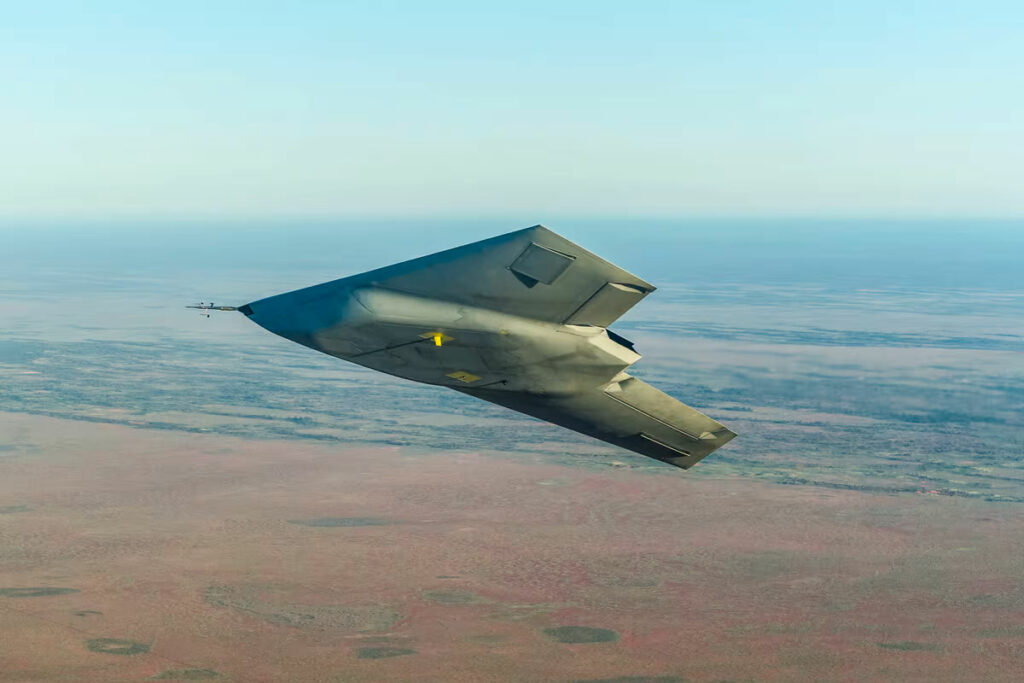The BAE Systems Taranis is a British unmanned combat air vehicle (UCAV) demonstrator, showcasing advanced stealth and autonomous capabilities.
The BAE Systems Taranis is an unmanned combat air vehicle (UCAV) technology demonstrator developed by BAE Systems in collaboration with the UK Ministry of Defence (MoD). Named after the Celtic god of thunder, Taranis is designed to test and develop technologies for stealth, autonomy, and low-observable operations. The aircraft features a delta-wing design with a wingspan of approximately 32.6 feet (9.94 meters) and a length of 37.2 feet (11.35 meters), comparable in size to the BAE Hawk trainer aircraft. Powered by a Rolls-Royce Adour 951 turbofan engine, it is capable of high subsonic speeds. Taranis incorporates advanced materials and design techniques to minimize radar and infrared signatures, enhancing its stealth capabilities. The UCAV is equipped with internal weapon bays, allowing it to carry precision-guided munitions while maintaining a low observable profile. Its autonomous systems enable it to perform a range of missions, including intelligence, surveillance, reconnaissance, and strike operations, with minimal human intervention.
History of the Development of the BAE Systems Taranis
In the early 2000s, the global defense landscape was rapidly evolving, with increasing emphasis on unmanned systems capable of performing complex missions autonomously. Recognizing the strategic importance of such technologies, the UK Ministry of Defence (MoD) initiated the Strategic Unmanned Air Vehicle (Experimental) (SUAV[E]) program to explore the potential of unmanned combat air vehicles (UCAVs).
In December 2006, BAE Systems was awarded a contract to develop a UCAV demonstrator under the project name “Taranis,” named after the Celtic god of thunder. The primary objective was to create an unmanned aircraft capable of delivering precision strikes over long distances, while evading detection through advanced stealth technologies. The program sought to position the UK as a leader in autonomous combat air systems, reducing reliance on manned aircraft for high-risk missions.
The development of Taranis was a collaborative effort involving multiple industry partners, including Rolls-Royce, responsible for the propulsion system; QinetiQ, providing expertise in autonomous systems; and GE Aviation Systems, contributing avionics and electrical systems. The project also engaged over 250 UK companies, reflecting a broad industrial commitment to advancing defense technologies.
The design phase focused on achieving a low-observable, highly autonomous aircraft capable of performing a range of missions, including intelligence, surveillance, reconnaissance, and precision strikes. Advanced materials and manufacturing techniques were employed to minimize radar and infrared signatures, enhancing the aircraft’s stealth capabilities.
By 2010, the Taranis demonstrator was unveiled to the public, showcasing a sleek, delta-wing design indicative of its stealth objectives. Ground testing commenced shortly thereafter, including evaluations of its radar cross-section and systems integration. These tests were crucial in validating the design’s low-observable characteristics and autonomous functionalities.
The maiden flight of Taranis took place on August 10, 2013, at the Woomera Test Range in Australia. During this 15-minute flight, the aircraft performed a series of maneuvers under the control of a human operator, demonstrating its basic flight capabilities. Subsequent test flights extended the duration and complexity of operations, with some flights lasting up to an hour and exploring various altitudes and speeds.
The successful flights of Taranis marked a significant milestone in the UK’s defense research, providing valuable data on the integration of autonomous systems, stealth technology, and UCAV operational concepts. The insights gained from the Taranis program have informed the development of future combat air systems, including potential contributions to international collaborative projects.
While Taranis itself is not intended for operational deployment, its development has been instrumental in advancing the UK’s understanding and capabilities in unmanned combat air systems. The program has demonstrated the feasibility of deploying highly autonomous, stealthy UCAVs capable of performing complex missions, thereby shaping the future direction of the UK’s air combat strategy.

Design of the BAE Systems Taranis
The BAE Systems Taranis showcases a design that integrates stealth, autonomy, and advanced aerodynamics to fulfill its role as a UCAV demonstrator.
Airframe and Stealth Features:
- Delta-Wing Configuration: Taranis features a tailless delta-wing design, optimizing aerodynamic efficiency and reducing radar cross-section.
- Dimensions: The aircraft measures approximately 37.2 feet (11.35 meters) in length, with a wingspan of 32.6 feet (9.94 meters), comparable to the BAE Hawk trainer aircraft.
- Materials: Constructed using advanced composite materials and radar-absorbent coatings to minimize detectability by enemy radar systems.
- Internal Weapon Bays: Equipped with internal bays to house munitions, maintaining a smooth external profile and enhancing stealth capabilities.
Propulsion System:
- Engine: Powered by a Rolls-Royce Adour 951 turbofan engine, providing a thrust of approximately 6,480 lbf (28.8 kN).
- Air Intake Design: Features a dorsal air intake to conceal engine components and reduce radar signature.
Autonomy and Avionics:
- Autonomous Systems: Taranis integrates advanced autonomous capabilities, enabling it to plan and execute missions with minimal human intervention. These systems allow for dynamic decision-making, such as route optimization and target prioritization.
- Avionics Suite: Developed in collaboration with QinetiQ and GE Aviation, the avionics suite includes a secure communication system, GPS, and advanced sensors for situational awareness.
Stealth Optimization:
- Radar Cross-Section (RCS): Taranis employs low-observable design principles, including blended wing surfaces, internal weapon bays, and radar-absorbent materials. These features significantly reduce its RCS, making it harder to detect by enemy radar.
- Infrared Suppression: The aircraft’s engine exhaust is designed to minimize heat emissions, reducing its infrared signature and improving survivability against heat-seeking missiles.
Operational Capabilities:
- Payload: The internal weapon bays can accommodate a range of precision-guided munitions, including small-diameter bombs and air-to-ground missiles.
- Sensor Integration: Equipped with electro-optical and infrared sensors for reconnaissance and targeting, providing real-time intelligence to ground operators.
Drawbacks:
- Experimental Nature: As a demonstrator, Taranis lacks the operational maturity of fully developed UCAVs, with limitations in endurance and payload compared to operational systems like the MQ-9 Reaper.
- Dependence on Secure Data Links: Autonomous systems rely on secure communications, making them vulnerable to electronic warfare and jamming in contested environments.
Taranis’ design underscores its role as a testbed for next-generation UCAV technologies, advancing the UK’s expertise in unmanned combat systems.
Performance of the BAE Systems Taranis
The BAE Systems Taranis delivers performance characteristics tailored for its role as a stealth UCAV demonstrator.
Engine and Power:
- Powered by the Rolls-Royce Adour 951 turbofan engine, generating a maximum thrust of 6,480 lbf (28.8 kN).
- The engine’s low-noise and efficient performance align with the aircraft’s stealth and endurance objectives.
Speed and Range:
- Estimated maximum speed of Mach 0.9 (690 mph or 1,110 km/h), allowing for high subsonic flight suitable for stealth operations.
- Operational range is estimated at 2,000 nautical miles (3,700 km), enabling long-endurance missions over vast areas.
Altitude:
- Capable of reaching altitudes of approximately 40,000 feet (12,200 meters), positioning it above most ground-based threats and providing an optimal vantage point for reconnaissance.
Payload Capacity:
- The internal weapon bays can carry a variety of munitions, including precision-guided bombs and missiles, with an estimated payload capacity of 2,000 pounds (900 kg).
Stealth Features:
- Radar Cross-Section (RCS): Taranis employs advanced stealth technologies, achieving a significantly reduced RCS. This ensures survivability in high-threat environments dominated by sophisticated air defense systems.
- Infrared Signature: Engine exhaust suppression minimizes infrared emissions, reducing detectability by heat-seeking sensors.
Comparison with Competitors:
- Compared to the Northrop Grumman X-47B, Taranis offers similar stealth capabilities but focuses more on demonstrating autonomous mission planning and execution.
- Against operational platforms like the MQ-9 Reaper, Taranis demonstrates superior stealth but lacks the same level of operational readiness and proven combat capability.
Taranis’ performance metrics highlight its role as a proof-of-concept aircraft, emphasizing advancements in stealth and autonomous systems rather than operational deployment.
Variants of the BAE Systems Taranis
Taranis is a single demonstrator program with no direct variants. However, its technologies have influenced the development of other systems and collaborative projects:
- Taranis Demonstrator:
- The original and sole variant developed under the SUAV(E) program.
- Focused on testing stealth, autonomy, and UCAV capabilities.
- Future Combat Air System (FCAS):
- Taranis has contributed to the UK’s participation in international programs like FCAS, aimed at developing operational UCAVs.
- Insights gained from Taranis have shaped design principles for future platforms.
- Project Mosquito:
- Leveraging Taranis technologies, the UK initiated Project Mosquito to develop a loyal wingman UAV. This program aims to complement manned fighters with autonomous systems.
While Taranis itself remains a demonstrator, its legacy continues to influence the design and development of operational UCAVs.

Military Use and Combat of the BAE Systems Taranis
As a technology demonstrator, the BAE Systems Taranis has not been deployed in combat. Its primary purpose is to test and validate technologies for future UCAV systems, rather than serving as an operational platform. However, its development offers insights into its potential applications in military operations.
Armament and Strike Capabilities
- Taranis is designed to carry precision-guided munitions within its internal weapon bays. Potential payloads include:
- Small-Diameter Bombs (SDB): For precision strikes against ground targets with minimal collateral damage.
- Air-to-Ground Missiles: Suitable for engaging armored vehicles and fortified positions.
Autonomous Operations
- The aircraft’s advanced autonomy allows it to perform missions such as:
- Intelligence, Surveillance, and Reconnaissance (ISR): Gathering real-time battlefield intelligence while maintaining a low observable profile.
- Precision Strikes: Engaging high-value targets with minimal operator intervention.
- Electronic Warfare (Conceptual): Potential for integration with electronic warfare systems to disrupt enemy communications and radar.
Global Influence
- Taranis has contributed to the UK’s participation in multinational defense programs, enhancing collaborative efforts with allies such as France and Germany.
- Its development underscores the UK’s commitment to maintaining technological parity with major global powers in the UCAV domain.
Limitations
- As a demonstrator, Taranis lacks the endurance, payload capacity, and operational reliability of combat-proven systems like the MQ-9 Reaper or X-47B.
- Dependence on secure data links makes it susceptible to electronic warfare.
Competing Systems
- Compared to the Northrop Grumman X-47B, Taranis focuses more on autonomy and stealth rather than carrier-based operations.
- The Dassault nEUROn shares similar objectives, with both programs advancing stealth and autonomous capabilities.
Future Prospects
While Taranis itself will not enter operational service, its technological advancements will shape future UCAVs and contribute to the UK’s defense capabilities. The insights gained from the program ensure that the UK remains a competitive player in the rapidly evolving field of unmanned aerial systems.
The BAE Systems Taranis serves as a pivotal platform for advancing stealth, autonomy, and unmanned combat technologies. While not intended for operational deployment, its contributions to the development of next-generation UCAVs are significant. The insights gained from Taranis will influence future systems, ensuring the UK’s continued innovation in aerospace defense.
Back to the Drones, UAVs, UCAVs page